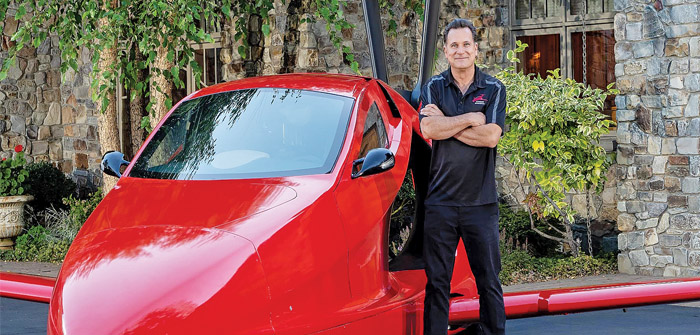(Sam Bousfield has spent 14 years developing the world’s most sought-after flying car | Photo courtesy of Samson Sky)
Sam Bousfield was in kindergarten when he first drew pictures of flying cars — the beginning of a journey that culminated decades later with the maiden flight of the world’s most sought-after flying sports car, the Switchblade. Asked how it felt to see the Switchblade fly — after 14 years of design and testing — Bousfield “realized that this is what it feels like when your dreams come true.”
“There have been hundreds of designs for flying cars, but no one has pulled it off until now,” he said. “One reason is that most people ask, ‘How do you make a car fly?’ when the question should be ‘what is the best configuration for a vehicle that both drives and flies?’ And along the way, the challenge became ‘how do you solve the problems that stopped others?’”
Bousfield, who believes that “the dreams of artists form society’s future” (think Leonardo de Vinci, who created the first designs for an aircraft in his 15th Century paintings), always felt that “the future of transportation is in the air.”
While admitting that “I lost sight of that goal” while pursuing an architectural career for 26 years, “I never gave up my dream of flying,” said Bousfield, “and finally decided to chase it.” And so the Switchblade saga was underway.
Modest about his artistic talents (“my paper mâché turkeys were always blobs”), Bousfield backed up his vision with an engineering mind — asking the question ‘how are we going to get there?’ as efforts moved toward attaining his goal of “supplying a practical, high-performance flying sports car that can improve people’s lifestyle.”
Among the key junctures in the process was deciding to classify the Switchblade as an experimental aircraft so as to allow design changes while adhering to FAA regulations. “That was the biggest box we could play in,” Bousfield said, “and gave us more latitude as refinements needed to be made. And with its three wheels (the minimum needed for ground stability and safety — with a single wheel in front that makes the vehicle more aerodynamic), the Switchblade is actually classified as a motorcycle.”
Bousfield said that the most time-consuming aspect of bringing the Switchblade to fruition was exploring a different process to make carbon fiber for the aircraft body. “It’s the lightest, strongest material possible (versus traditional metals such as steel and aluminum), but hideously expensive, toxic, and tough to produce.”
Ten years of research in finding an alternative led to the decision to use thermal plastic, carbon fiber, which Bousfield described as “eight times faster at half the price. It has 100 percent less waste, is non-toxic for factory workers, and is also fully recyclable.”
Since the Switchblade’s successful maiden flight in early November, the company Bousfield founded — Samson Sky, of which he is CEO — “is now in the production engineering stage, with a target of going into production in two+ years.”
Meanwhile, he said, “The rigorous testing and refinement that have marked this journey all along the way — and which were integral to our successful maiden flight — will continue. We’ll beat them up and try to break them. (Bousfield gives the example of a one-week trade show in the Midwest, where the Switchblade’s wing swing was constantly in motion — the equivalent of ten years use in seven days — as people gathered around to see how the Switchblade worked.)
The number of customer reservations for the flying car — now totaling more than 2,300 from 57 countries — “goes up daily,” Brousfield said. “It’s fun to see that it’s their dream, too.”
Expected to cost $170,000, the Switchblade:
- Can drive at speeds up to 125 mph and fly at an estimated maximum speed of 190 mph at altitudes of up to 13,000 feet.
- Uses unleaded auto gasoline rather than leaded aviation fuel, which allows owners to fill up the tank at any highway gas station.
- Will allow customers to drive their street-legal Switchblade from their garage directly to an airport. Once there, the vehicle can be transformed to flying mode in less than three minutes, and fly up to 500 miles without needing to refuel.
- Requires a private pilot’s license. Those without one “can use the Switchblade as their training vehicle,” Bousfield said, “which cuts the cost of obtaining a pilot’s license in half. People are learning and developing skills on the aircraft they’ll be flying — which is a good way to go.”
- Can always be used on the ground, including “as a commuter vehicle,” suggested Bousfield.
His enthusiasm undimmed by 14 years of unremitting work to get to this point, Bousfield said, “I’m super-excited in letting people know about the Switchblade.” He admitted, however, that “at certain points, attaining our goal seemed insurmountable, and my wife Martha and I had to step back and ask ‘are we prepared to do what it takes?’”
“We are fortunate — or darn lucky — in the choices we made,” said Bousfield. “We’ve done a lot of things right in going down this path to ensure a successful future for the Switchblade, and provide a benefit to society as well.”





